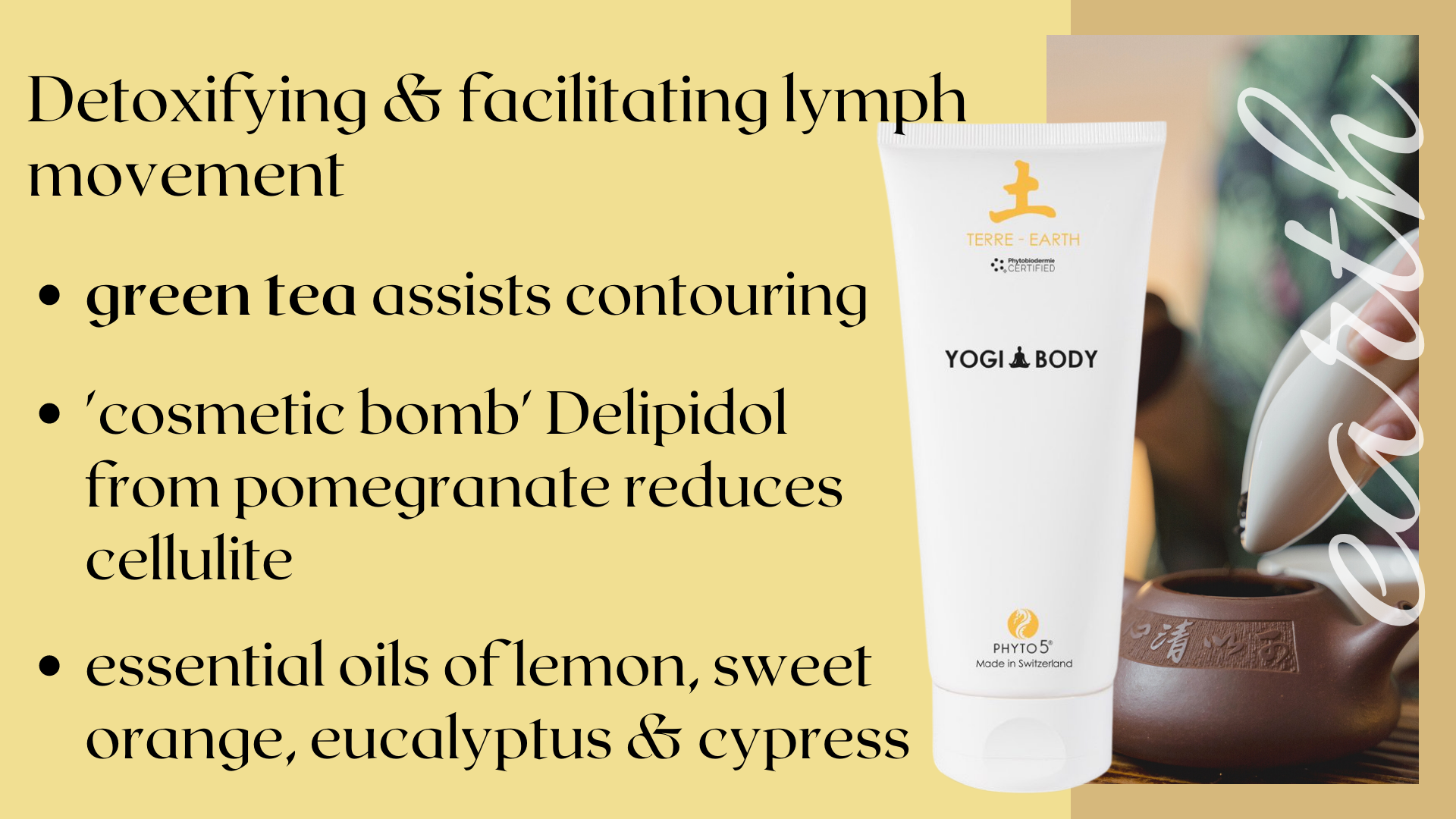Green tea extract is effectively absorbed through the skin and provides skin with a whole host of nourishing, protective and age mitigating actions. Skin has measurably more health, vibrancy, elasticity and firmness after continued application of green tea containing skincare. This is why green tea is a vital unique ingredient in PHYTO5’s Earth element Yogi Body Gel, a product that effectively reduces the appearance of ‘orange peel thighs’ or cellulite.
More than 150 in vitro and in vivo studies have reported the benefits of green tea for skin. A number of mechanisms in green tea appear to be responsible.
Green tea extracts play a protective role in preventing free radical damage that may result in skin tumors, cancers and DNA damage (Chiu and Kimball, 2003).
The methylxanthines(1) in green tea extracts help stimulate skin microcirculation and therefore influence skin’s health. For this reason, green tea polyphenols can be used as an anti-aging ingredient in skincare as it fights inflammation that induces premature aging.
Green tea is a potent antioxidant, anti-inflammatory, anticarcinogenic and vulnerary (wound healer), studies show.
The research also shows that green tea extract “can be exploited against a variety of skin disorders. Although more clinical studies are needed, supplementation of skin care products with green tea may have a profound impact on various skin disorders in the years to come.” —S. K. Katiyar et al in “Green Tea and Skin”
Green tea’s antioxidant, anti-inflammatory, and antimicrobial properties makes it effective against acne and oily skin. When green tea is applied to the skin, its polyphenols(2) help reduce sebum secretion which may lead to acne.
Green tea contains polyphenolic compounds also known as epicatechins(3) which are antioxidant in nature. These polyphenols have been found to limit the rate of cell death when cells are vigorously exposed to ultraviolet radiation. The polyphenols in green tea protect the cells against damage from sunlight and reddening of the skin. Research has proven that topical application of green tea to skin one half hour before ultraviolet light exposure protects the user against sunburn and epidermal damage (Elmets et al 2001). The effect is largely due to EGCG (the catechin,(4) Epigallocatechin gallate), a primary polyphenol in green tea. EGCG is 20 times more powerful than vitamin E as a free radical neutralizing antioxidant.
In fact, Dr. Andrew Weil(5) found that EGCG in green tea shows “impressive activity against many kinds of cancer, while appearing to protect the heart and arteries from oxidative damage.” It contributes to a healthy heart and even blood pressure as it works on strengthening the lining of the blood vessels.
Those who consistently drink green tea are shown to have greater dilation of the arteries on ultrasound 30 minutes after drinking the tea compared to those drinking simple hot water or a diluted caffeine beverage. Slightly less than 1/4 ounce of green tea consumed daily or three to four cups of tea per day is all that’s required to achieve healthier cardiovascular function.
In addition, you get a healthy dose vitamin C when consuming green tea–approximately 280 mg in every 3.5 ounces of raw tea.
One 2009 Japanese scientific study conducted by Tokushima Bunri University found that green tea is able to effectively fight against the H1N1 influenza virus.
In addition to protecting cells and organs including skin, consuming green tea helps reduce stress and assists to creates balance of body and mind acting like a natural medicine.
Besides drinking green tea for its enjoyment or applying topically to the skin, green tea is beneficial to:
Curb an overactive appetite by drinking one cup before meals
Fertilize plants with leftover green tea leaves from steeping tea
Prevent or lessen dental cavities
Refresh the mouth since its tannin content removes stickiness and bad breath, also killing bacteria
Deodorize and freshen the air (by simply boiling some on your stovetop)
Stimulate the mind and mental faculties
#####
(1) A naturally occurring mild stimulant
(2) A type of naturally occurring plant antioxidative compound that protects the body's tissues against oxidative stress and associated pathologies such as cancers, coronary heart disease and inflammation.
(3) One of the most abundant flavonoids (plant pigments) present in different fruits such as apples, blackberries, broad beans, cherries, grapes, pears, raspberries, cocoa, and also in tea leaves.
(4) Natural antioxidants that help prevent cell damage among other benefits
(5 )Andrew Weil, MD is founder and director of the Andrew Weil Center for Integrative Medicine at the University of Arizona, where he also holds the Lovell-Jones Endowed Chair in Integrative Rheumatology, and is Clinical Professor of Medicine and Professor of Public Health.
#####
Endnotes:
Juneja, Lekh R., et al. Green Tea Polyphenols: Nutraceuticals of Modern Life. CRC Press, 2016.
Chiu, A., and Kimball, A. B. 2003. Topical vitamins, minerals and botanical ingredients as modulators of environmental and chronological skin damage. Br J Dermatol, 149; 681-691.
Braun, Lesley, and Marc Cohen. Essential Herbs & Natural Supplements. Elsevier Australia, 2017.
Kayaki, Toshimi A. Green Tea Living: a Japan-Inspired Guide to Eco-Friendly Habits, Health and Happiness. Stone Bridge, 2010.
H;, Katiyar SK;Ahmad N;Mukhtar. “Green Tea and Skin.” Archives of Dermatology, U.S. National Library of Medicine, pubmed.ncbi.nlm.nih.gov/10926734/.
CA;, Katiyar SK;Elmets. “Green Tea Polyphenolic Antioxidants and Skin Photoprotection (Review).” International Journal of Oncology, U.S. National Library of Medicine, pubmed.ncbi.nlm.nih.gov/11351267/.
Photo pouring green tea by Tima Miroshnichenko at Pexels

